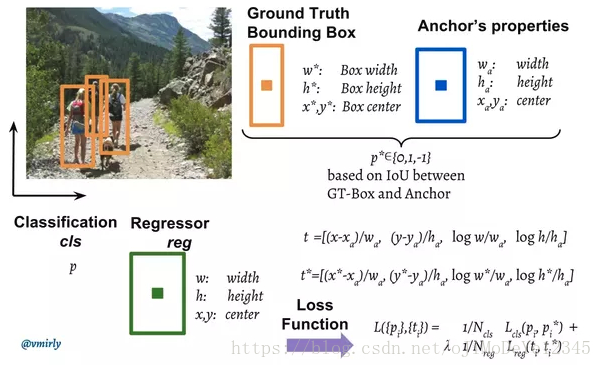Faster R-CNN 中 RPN 原理简介.
1. RPN 原理
RPN 的用途在于, 判断需要处理的图片区域(where), 以降低推断时的计算量.
RPN 快速有效的扫描图片中每一个位置, 以判断给定区域是否需要进一步处理. 其产生 k 个 bounding-box proposals, 每一个 box proposal 有两个分数, 分别表示该 box 中是 object 的概率.
anchor 用于寻找 boxes proposals.
anchor boxes 是参考 boxes, 所选择的 anchors 具有不同的长宽比(aspect ratios) 和尺度(scale), 以囊括不同类型的 objects.
细长的 objects, 如 buses, 则不能用方形square bounding box 来合适的表示.
Faster R-CNN 采用了 k=9 个 anchors, 分别为 3 aspect ratios 和 3 scales.
RPN 的每个 regressor 只计算与对应参考 anchor box 的 4 个偏移值 (w, h, x, y).
RPN 采用 3x3 的滑窗, 其有效的接受野实际上是 177x177. 因此, RPN 在生成 proposals 时用到了大量的内容信息.
RPN 主要可以包括三步:
[1]. 输入图片经卷积网络(如 VGGNet 和 ResNet)处理后, 会输出最后一个卷积层的 feature maps;

[2]. 在 feature maps 上进行滑窗操作(sliding window). 滑窗尺寸为 nxn, 如 3x3.
对于每个滑窗, 会生成 9 个 anchors, anchors 具有相同的中心 center = x_a, y_a, 但 anchors 具有 3 种不同的长宽比(aspect ratios) 和 3 种不同的尺度(scales), 计算是相对于原始图片尺寸的, 如下图:

对于每个 anchor, 计算 anchor 与 ground-truth bounding boxes 的重叠部分(overlap)值 ${ p^* }$ - IoU(intersection over union ):
如果 IoU > 0.7, 则 ${ p* = 1 }$;
如果 IoU < 0.3, 则 ${ p^* = -1 }$;
其它, ${ p^* = 0 }$
[3]. 从 feature maps 中提取 3x3 的空间特征(上图中红色方框部分), 并将其送入一个小网络. 该网络具有两个输出任务分支: classification(cls) 和 regression(reg).
regression 分支输出预测的边界框bounding-box: (x, y, w, h).
classification 分支输出一个概率值, 表示 bounding-box 中是否包含 object (classid = 1), 或者是 background (classid = 0), no object.

2. Anchors 生成示例
Detectron 中 generate_anchors.py 给出了 anchors 的实现.
主要包括两步:
- 保持 anchor 面积固定不变, 改变长宽比(aspect ratio) -
_ratio_enum(anchor, ratios) - 保持 anchor 长宽比固定不变,缩放尺度scale -
_scale_enum(anchor, scales)
最终生成 5*3=15 个 anchors.
"""
generate_anchors.py
"""
import numpy as np
# Verify that we compute the same anchors as Shaoqing's matlab implementation:
#
# >> load output/rpn_cachedir/faster_rcnn_VOC2007_ZF_stage1_rpn/anchors.mat
# >> anchors
#
# anchors =
#
# -83 -39 100 56
# -175 -87 192 104
# -359 -183 376 200
# -55 -55 72 72
# -119 -119 136 136
# -247 -247 264 264
# -35 -79 52 96
# -79 -167 96 184
# -167 -343 184 360
# array([[ -83., -39., 100., 56.],
# [-175., -87., 192., 104.],
# [-359., -183., 376., 200.],
# [ -55., -55., 72., 72.],
# [-119., -119., 136., 136.],
# [-247., -247., 264., 264.],
# [ -35., -79., 52., 96.],
# [ -79., -167., 96., 184.],
# [-167., -343., 184., 360.]])
def generate_anchors(stride=16, sizes=(32, 64, 128, 256, 512), aspect_ratios=(0.5, 1, 2)):
"""
生成 anchor boxes 矩阵,其格式为 (x1, y1, x2, y2).
Anchors 是以 stride / 2 的中心,逼近指定大小的平方根面积(sqrt areas),长宽比
Anchors are centered on stride / 2, have (approximate) sqrt areas of the specified
sizes, and aspect ratios as given.
"""
return _generate_anchors(stride,
np.array(sizes, dtype=np.float) / stride,
np.array(aspect_ratios, dtype=np.float) )
def _generate_anchors(base_size, scales, aspect_ratios):
"""
通过枚举关于参考窗口window (0, 0, base_size - 1, base_size - 1) 的长宽比(aspect ratios) X scales,
来生成 anchore 窗口(参考窗口 reference windows).
"""
anchor = np.array([1, 1, base_size, base_size], dtype=np.float) - 1
anchors = _ratio_enum(anchor, aspect_ratios)
anchors = np.vstack([_scale_enum(anchors[i, :], scales) for i in range(anchors.shape[0])])
return anchors
def _whctrs(anchor):
"""
返回 anchor 窗口的 width, height, x center, y center.
"""
w = anchor[2] - anchor[0] + 1
h = anchor[3] - anchor[1] + 1
x_ctr = anchor[0] + 0.5 * (w - 1)
y_ctr = anchor[1] + 0.5 * (h - 1)
return w, h, x_ctr, y_ctr
def _mkanchors(ws, hs, x_ctr, y_ctr):
"""
给定 center(x_ctr, y_ctr) 及 widths (ws),heights (hs) 向量,输出 anchors窗口window 集合.
"""
ws = ws[:, np.newaxis]
hs = hs[:, np.newaxis]
anchors = np.hstack( (x_ctr - 0.5 * (ws - 1), y_ctr - 0.5 * (hs - 1),
x_ctr + 0.5 * (ws - 1), y_ctr + 0.5 * (hs - 1) ) )
return anchors
def _ratio_enum(anchor, ratios):
"""
对于每个关于一个 anchor 的长宽比aspect ratio,枚举 anchors 集合.
"""
w, h, x_ctr, y_ctr = _whctrs(anchor)
size = w * h
size_ratios = size / ratios
ws = np.round(np.sqrt(size_ratios))
hs = np.round(ws * ratios)
anchors = _mkanchors(ws, hs, x_ctr, y_ctr)
return anchors
def _scale_enum(anchor, scales):
"""
对于每个关于一个 anchor 的尺度scale,枚举 anchors 集合.
Enumerate a set of anchors for each scale wrt an anchor."""
w, h, x_ctr, y_ctr = _whctrs(anchor)
ws = w * scales
hs = h * scales
anchors = _mkanchors(ws, hs, x_ctr, y_ctr)
return anchors
if __name__ == '__main__':
print 'Anchor Generating ...'
anchors = generate_anchors()
print anchors
print 'Done.'3. Related
[1] - Faster R-CNN - 目标检测详解
[2] - How does the region proposal network (RPN) in Faster R-CNN work?
[3] - 论文阅读 - Faster R-CNN